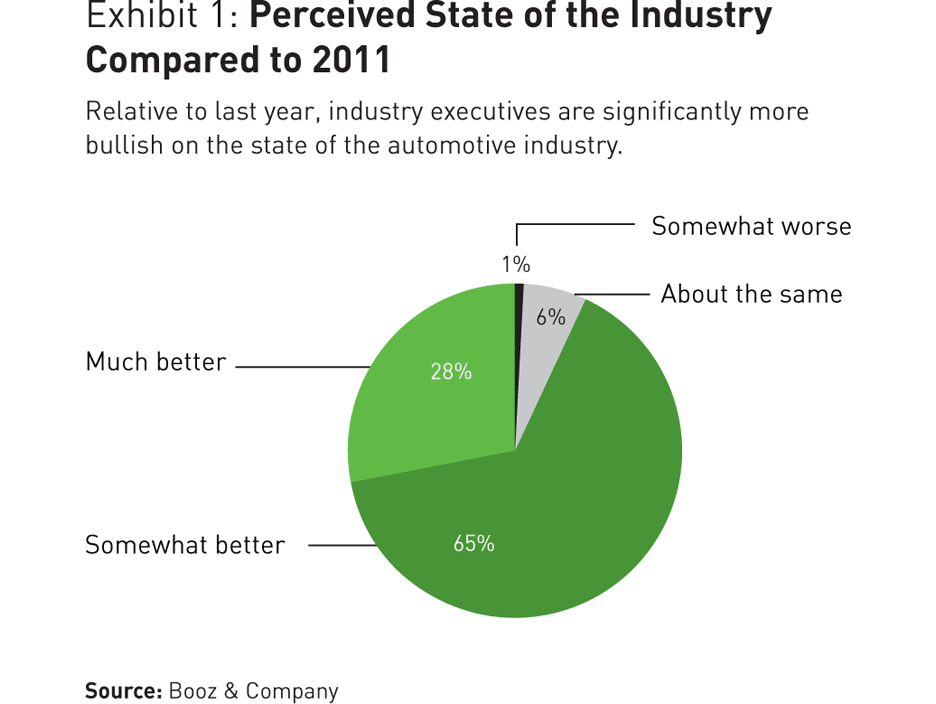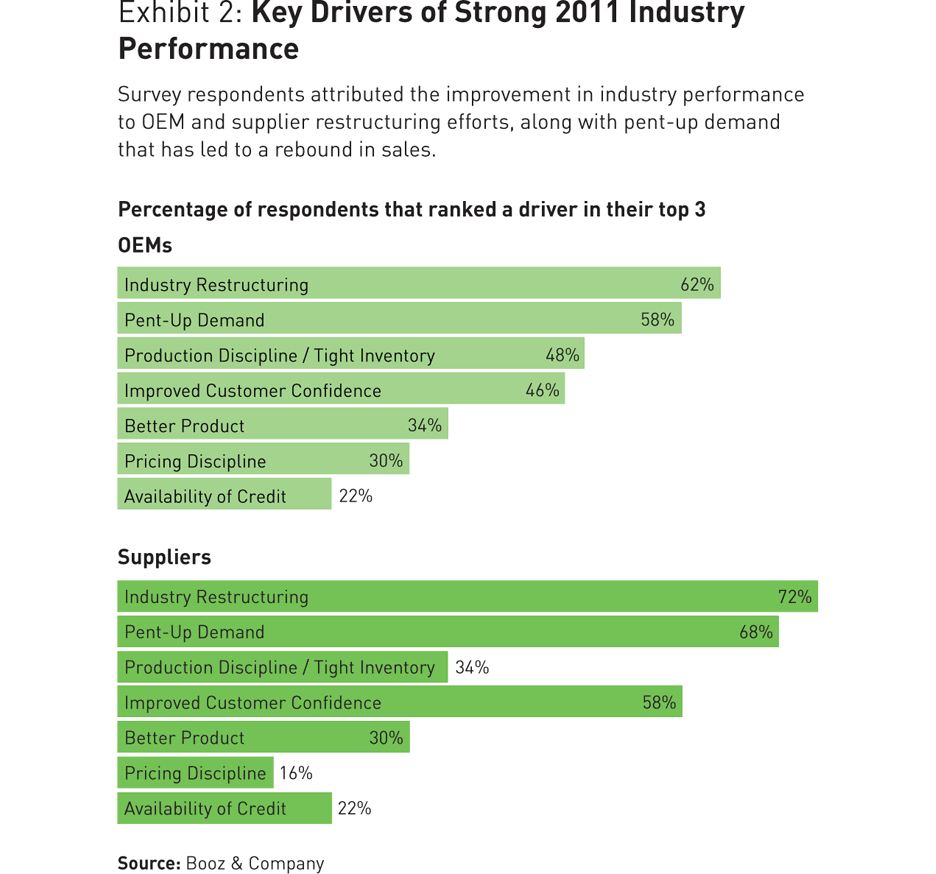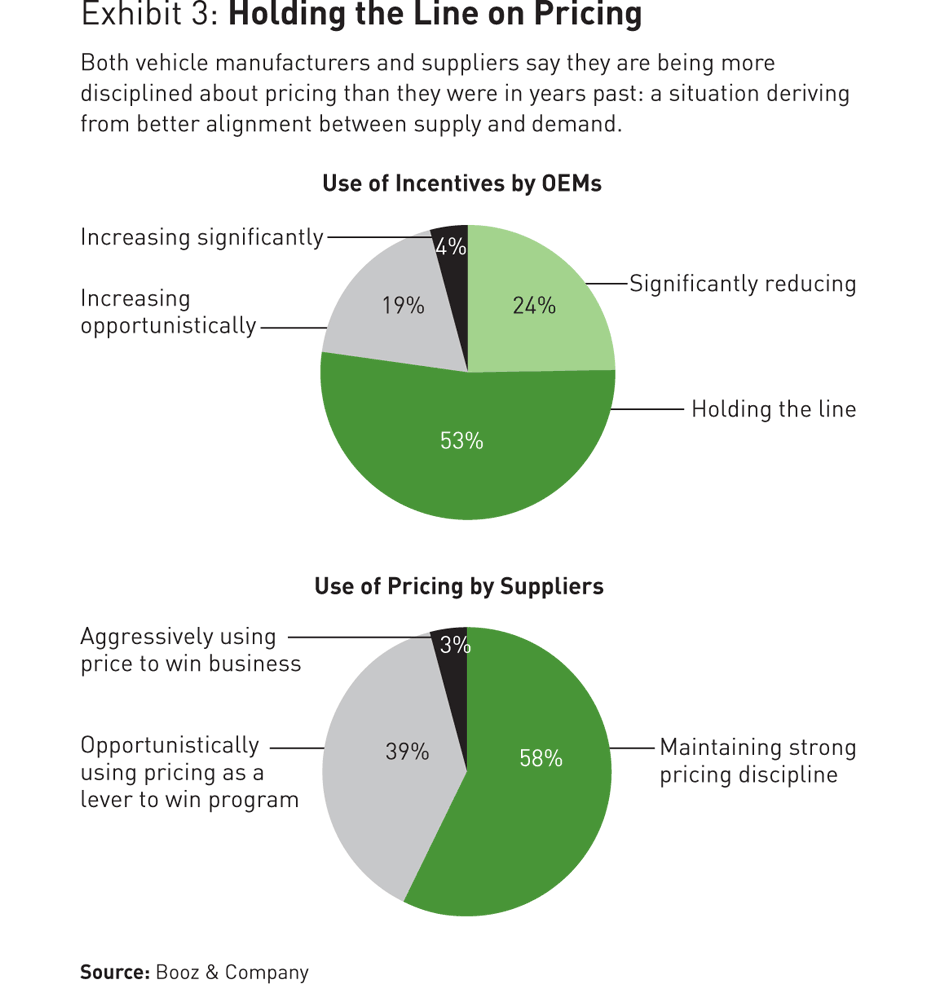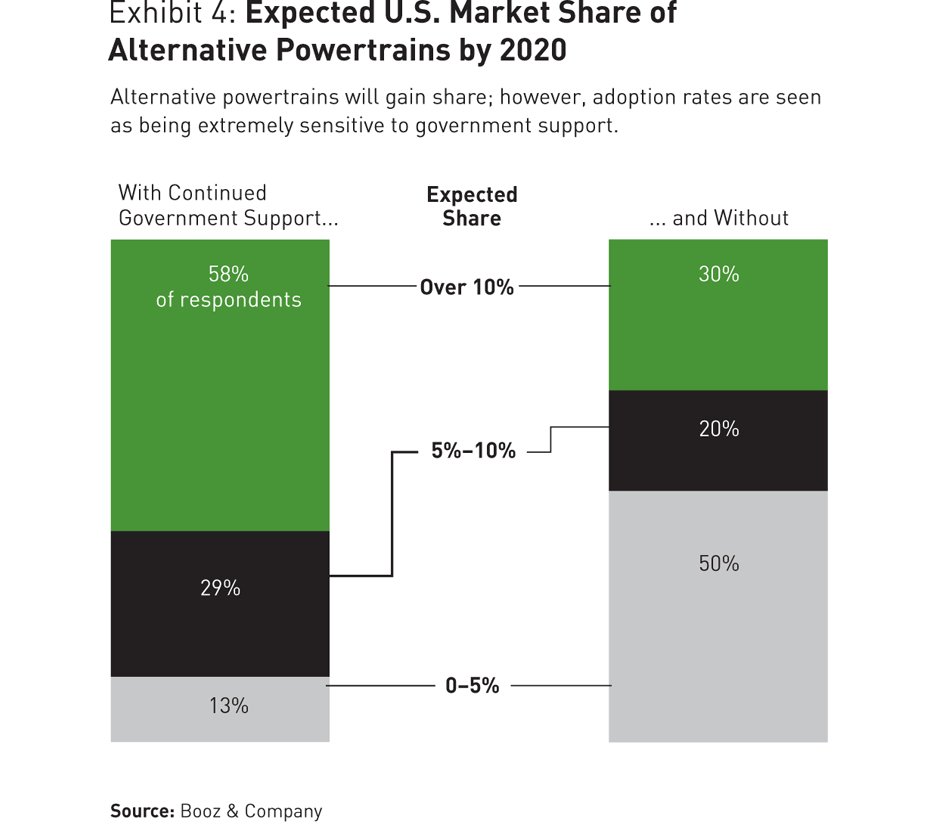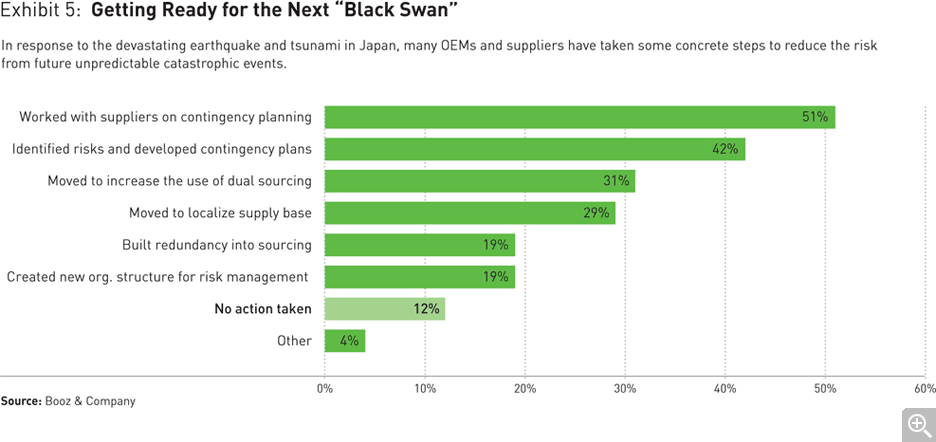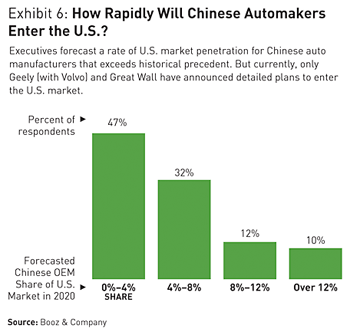Optimism Returns to the American Automotive Industry
Automobiles are selling again, and executives are confident. The U.S. auto industry is positioned for a global economic recovery — if car manufacturers can avoid repeating the mistakes of the past.
The U.S. auto industry is emerging from one of the darkest periods in its history. Car sales are climbing, and most estimates predict total sales of more than 14 million vehicles in 2012, an increase of nearly 9 percent over 2011. Car manufacturers and suppliers are increasingly profitable, and many automotive industry executives are more bullish about their own prospects, and those of the industry at large, than they have been for years.
More than 200 executives from 75 automakers, suppliers, and dealer groups responded to Booz & Company’s annual U.S. Automotive Industry Survey and Confidence Index, conducted in February and March. Ninety-three percent of the survey respondents view the industry as stronger than a year ago. This is in stark contrast to the results from the 2011 survey, when more than half of all respondents said the industry was about the same as or worse than in 2009. (See Exhibit 1.) Unlike housing, which is still searching for a bottom, the automotive industry has emerged from the lows of the 2008–09 recession with a much stronger and more stable foundation for profitable growth.
It’s a success story that would have seemed implausible in 2009. The industry’s current strength stems from a combination of external forces and the industry’s own improvement, resulting in a far better alignment between supply and demand. (See Exhibit 2.) On the supply side, 65 percent of respondents cited the auto industry’s restructuring as one of the top three drivers of strong performance. Automotive companies have gone to great lengths to improve balance sheets, remove excess capacity, and reduce costs. These efforts have allowed both suppliers and manufacturers to lower their break-even point, enabling them to turn a profit on a much smaller total industry volume.
Better product offerings are a significant factor as well, and new vehicle launches are offering a level of performance, technology, safety features, and fuel efficiency never before seen — giving customers far better value than in the past. Quality ratings for the industry as a whole are continuing to improve, and the gap between domestics and imports has narrowed considerably.
Externally, several factors are turning in the industry’s favor. Consumer confidence is increasing and credit is more widely available. Rising fuel prices are prompting some buyers to upgrade to more fuel-efficient models. Pent-up demand is also spurring sales. The average U.S. car today is more than 10 years old and has logged more than 100,000 miles; both numbers are far above historical averages. Many consumers who put off purchasing a new car during the recession have less reason to do so now.
The new U.S. auto industry has some major differences from the old one, however. For one thing, the current optimism among executives is noticeably tempered. The industry has expressed a sober consensus that it needs to grow intelligently, preventing capacity from growing faster than natural market demand. Projected industry volume of roughly 14 million cars and light trucks in 2012 still represents a drop of nearly 20 percent from the levels sustained through much of the 2000s, which hovered at 16 million to 17 million. Yet this lower baseline represents a much better equilibrium between supply and demand. Instead of focusing on volume and share, automakers are working to build brand equity with consumers, improve the customer experience, strengthen their cost position, and compete globally. Similarly, suppliers have managed to regain some leverage in their relationships with manufacturers, and they’re working to stretch existing production capacity, rather than invest in new fixed assets. “The industry is the most rational it’s been in my 30 years of experience,” says Dave Cosper, vice chairman and CFO at Sonic Automotive, which has more than 100 dealerships in 15 states and sells 30 makes.
Among vehicle manufacturers, this entails a new approach: fewer, more profitable car sales each year. One clear sign of this shift in orientation is production capacity. Instead of ramping up to match the highest rate of recovery — the equivalent of recalibrating to the high-water mark — vehicle manufacturers are maintaining a highly disciplined stance. Certain manufacturers are operating with very low inventories; for example, some report as few as 15 to 20 DSO (days sales outstanding), which is far lower than the peak levels of 100 DSO experienced a few years ago.
Hyundai is a good example. Among respondents to our survey, 88 percent expect Hyundai and its affiliate brand, Kia, to grow share over the next five years, more than any other manufacturer. Yet Hyundai has publicly stated that it does not have a goal of aggressively increasing U.S. sales. Instead, it is focusing on improving its quality rankings and brand perception.
Survey respondents also said that Ford, Volkswagen/Audi, and, to a lesser degree, BMW would gain market share over the next five years. Yet relative market share is no longer as significant as it was five years ago — another way in which the industry has changed recently. In a rising market, now that manufacturers have effectively lowered their cost base to become profitable at lower volumes, they can enjoy the benefit of annual increases in market volumes, selling more vehicles profitably and not obsessing over slivers of share to the degree that they did in the past. This will also enable them to maintain a better balance between supply and demand, and focus on medium- and long-term profitability. As Daniel Akerson, the CEO of General Motors, told reporters at the North American International Auto Show in Detroit in January, “I like profitability more than I do market share.”
These industry dynamics have also helped manufacturers remain disciplined about pricing. (See Exhibit 3.) Many auto manufacturers have reduced their need to rely on sales incentives, which were useful when supply greatly exceeded demand. According to Edmunds.com, sales incentives for March were down more than 3 percent from the prior month, and nearly 10 percent from March 2011, putting them at their lowest level for any March since 2002.
It is worth noting that these gains come during a period when sales are rising rapidly and price discipline is easier to maintain. Some in the industry question whether this discipline can last. “I’m not sure we’ve really slain the dragon yet,” says Scot Eisenfelder, vice president of strategy at AutoNation. “I still see evidence of push-based distribution, whether it’s in pockets of particular vehicles or whole model lineups. We don’t have a system that reflects true demand.” The real test will come when the market experiences a month — or several — of slow sales and inventories build up. When that happens, will automakers stay disciplined and work to “sell the car”? Or will they try to “sell the deal”?
Suppliers have also become much more disciplined about pricing and production. This is a significant change from recent years, when many auto suppliers struggled to earn a return on their invested capital. For far too long, many suppliers had been burdened with a huge asset base — after investing heavily to meet the often over-optimistic sales estimates of carmakers — and were caught in a downward spiral of bidding down their prices in a quest to win business at all costs and fill the factory. When sales declined in 2009 and 2010, the situation became untenable; more than 60 suppliers filed for bankruptcy and hundreds of smaller companies simply folded.
Now, suppliers have managed to regain some leverage over manufacturers, and they are loath to surrender that leverage. A survey by the Original Equipment Suppliers Association found that 76 percent planned to run overtime shifts in the first quarter of 2012, and more than half of our respondents said they were constrained by capacity. In other words, even as overall volumes and orders rise, many suppliers are choosing to postpone investing in new fixed assets that would increase production capacity, opting instead to add overtime shifts and other incremental approaches in order to optimize their existing capacity.
With this better alignment between supply and demand, suppliers are now in a much stronger position to set sustainable prices. The days of suppliers providing big price markdowns may be over. In interviews, suppliers who had complained for years about “taking it on the nose” now say the crisis has shifted the balance of power. Many supplier sectors no longer have excess capacity. In particular, suppliers that are truly differentiated — in terms of technology, manufacturing, or branding — report that they have more leverage now over manufacturers than ever before.
Given the likely continued increase in sales, suppliers can afford to postpone new capital investments for only so long. In making these choices on how and where to expand, suppliers must bear in mind their relative competitive positioning, their strategic goals, and their own independent view of demand — developing more advanced and analytically rigorous capabilities and linking all the pockets of knowledge in individual business units. Furthermore, these new investments should be made only after all steps have been taken to stretch current capacity. (See “Memo to Suppliers: Improve Your Capacity Planning,” below.)
Four Key Forces for the Future
The survey results illustrate several fundamental forces that will collectively shape the U.S. auto industry over the coming years: (1) a reemergence of fundamentals, (2) a shift in demand centers, (3) uncertainties about alternative powertrains and other technology, and (4) an increasingly interconnected supply chain.
First, the reemergence of fundamentals is evident throughout the survey results, which illustrates just how much potential this industry has to be a profit engine. Many major auto manufacturers and suppliers effectively hit the reset button to make more efficient use of production capacity and generate a profit at lower volumes. Now, as sales volumes rebound, driven in large part by pent-up demand, easier credit, and greater consumer confidence, executives are seeing these efforts pay off. Many companies report record profitability since mid-2011. Also, as one might expect in a product-led recovery, the industry leaders tended to express strong confidence in their current portfolio. In our view, these findings represent a sober, collective recognition on the part of auto companies and suppliers that they need to grow intelligently and not chase sales volume for its own sake.
The second key force that will shape the industry is the shift in demand around the world. The U.S. remains the most profitable automotive market, and the place where all global manufacturers need to succeed. But over the long term, emerging markets have much stronger growth prospects. Automakers must preserve their competitive position in developed, mature markets while also funding the investment necessary for longer-term growth elsewhere. To that end, they need a better understanding of emerging markets — which have unfamiliar economics, consumer profiles, and competitive dynamics.
Third, there are real uncertainties about alternative powertrains — including electric vehicles, fuel cells, and hybrids — and other technologies. The industry is on the cusp of significant technological changes that could result in paradigm-shifting innovation. Whether a company is a leader or a follower, playing in these new markets will require a significant investment in both financial and human capital. Companies should thus be very selective in placing their bets; they should invest only where they have confidence that they have the distinctive capabilities necessary to win, and that these investments are coherent with their broader strategy.
One major uncertainty about alternative powertrains is the level of government support they will receive. Half of the respondents to the survey said that this segment will remain limited to 5 percent or less of the U.S. market in 2020 — without government support. (See Exhibit 4.) But close to 60 percent of respondents said that if the U.S. government continues or expands its support of alternative powertrains, they expect penetration of 10 percent or more of the U.S. market by 2020.
Either way, government subsidies for consumers who buy these cars, along with support for companies working to advance alternative powertrains, have an uncertain future, given the current fiscal environment. In the end, adoption of this automobile segment will depend not just on continued support but on the right kind of support. Truly disruptive technologies such as plug-in vehicles will require a more balanced approach to government assistance, such as infrastructure support for a national grid of charging stations.
Even with government support, adoption rates of alternative powertrain vehicles have fallen short of expectations thus far, because the inherent cost differences have proven too substantial to be recovered without a sizable and sustained increase in fuel prices. Below-expected sales volume has made it difficult for manufacturers to recoup their own investments, at least so far. Differences across geographic markets pose an additional level of complexity — given national variations in energy supply and consumption, no single powertrain technology will replace the internal combustion engine.
“A lot depends on advancement in technology,” says Mark McNabb, president and CEO of Maserati North America. “Battery technology has to be more enhanced to make a strong business case. It’s a higher cost, and the anxiety over range is an issue for plug-ins with a lot of consumers. I think success hinges on two factors: a coherent government policy, and how quickly the technology can advance. In the meantime, manufacturers are spending a lot of money working on this, and they’re spreading it around to a lot of different ideas.”
A more immediate return could come from enhanced investments to improve the fuel economy of traditional internal combustion engines. “There’s still a lot of life left in that technology,” says Scot Eisenfelder of AutoNation. “Through design changes and other incremental gains, you can generate a significant improvement in fuel economy without relying on a disruptive technology.”
This same uncertainty applies to in-vehicle connectivity and entertainment. Approximately 40 percent of manufacturers that responded to our survey expressed plans to develop their own proprietary in-vehicle technology for consumer digitization — providing advanced customized electronics and inboard access to a variety of media. This may be a potentially risky strategy, given the fact that personal technology devices have far shorter product cycles than automobiles — witness the ubiquity of GPS systems on mobile phones — and the way that a single family may have multiple drivers who share multiple cars.
The fourth and final force that will shape the industry in the coming years is an increasingly interconnected supply chain. In 2011, the Japanese tsunami and the floods in Thailand brought home the limitations of a lean global supply chain facing “black swan” events. Many of the incremental benefits from just-in-time inventory evaporated in six months, especially at manufacturers that had limited safety stocks. Among respondents to the survey, more than 80 percent said they were affected by the Japanese earthquake and tsunami (although some were helped by risk mitigation measures already in place).
Since then, both suppliers and manufacturers have taken steps to prevent similar mishaps. They assessed the damage, weighed future events and probabilities, and are working with each other to be better prepared. In the past year, 19 percent of manufacturers have built new organizational capabilities to manage risk, an implicit admission that sufficient mechanisms were not in place before the quake. For suppliers, these risks, although daunting, offer an upside opportunity. Companies that differentiate themselves by shock-proofing their end of the supply chain will have a clear competitive advantage beyond price. (See Exhibit 5.)
It is not clear whether the industry is now fully prepared for the next black swan event. Risk mitigation measures are expensive, and, in a brutally competitive sector, they eat into margins. Accordingly, companies in the industry must determine an appropriate level of investment — low enough to be cost-effective, and high enough to ease the risk of being surprised by the next supply chain disruption.
Capabilities for Growth
The executives of the auto industry’s leading companies have many reasons to feel proud this year. They haven’t coasted on bailouts; they have learned some hard lessons and built a stable platform for profitable growth. They now face several external risks, including changes in government regulation, potential fuel disruptions from the Middle East, and continued economic woes in Europe. Yet if history is any guide, the greater risk could be from becoming overly optimistic about the market and expanding to meet demand that does not materialize quickly.
“In my experience, after 30 years in this business, every year someone else says, ‘I’m the guy with the great product lineup, and so I’m going to open a new plant, add more shifts,’ ” says Robert Fazio, executive director of sales operations at Edmunds.com. “The high-potential dollars per unit are just too enticing. And the capacity creeps up.” If that happens, and others try to keep pace, supply will begin to overtake demand, steep incentives will reappear, and the industry will be back in a situation of too much capacity, relying on incentives to move cars.
Here’s another scenario, though: If the U.S. auto industry can stay disciplined and preserve the efficiencies it fought so hard to implement, it will remain cost-competitive with the most efficient car markets in the world. It will be smaller than it was in the artificially inflated boom years of the past, but will have a far greater focus on fundamentals. And it will sell higher-quality cars at greater profits. Which path the industry takes lies within its own control, provided it can avoid repeating the mistakes of the past.![]()
Memo to Suppliers: Improve Your Capacity Planning
by Arvind Kaushal and Steven Eldam
As demand rebounds, suppliers are working hard to stretch current capacity further and postpone committing to major capital investments until absolutely necessary. This is a tightrope act in which the consequences of miscalculation are steep — including potentially shutting down vehicle production at a manufacturer and losing that business forever.
An objective, integrated view of short- and long-term demand is a critical first step in developing the right response to the capacity gap challenge. Although it’s important to understand your customers’ view of demand growth projections, that should not be the only major consideration. The key to developing confidence in your demand forecast is to triangulate the external and internal views, gathered from across the organization, using them to develop an integrated view of various demand scenarios. This growth projection capability is at a nascent stage at many suppliers and is often the basis of disconnection between sales and operations.
Once you have a clearer idea of capacity requirements needed to fill the gap in the short and long term, you can consider specific measures to increase capacity while optimizing significant investments in fixed assets. For example:
• Increase production hours or staffing levels by using existing shifts to schedule overtime production or adding shifts to increase overall capacity.
• Eliminate production bottlenecks by increasing staffing levels, adding equipment, or outsourcing non-core processes to generate better throughput.
• Improve overall equipment effectiveness (OEE) by enhancing equipment availability, increasing productivity, and improving quality.
• Increase flexibility of existing equipment to provide the capability to shift production between facilities or between production lines within facilities.
• Invest in new capacity if needed to meet lasting high demand.
To help you decide on the set of options that would work best for your company, consider formulating responses to the following key questions:
• How confident are you in the demand forecast?
• Is the expected demand–capacity gap short term or long term?
• Would incremental capacity improvements without significant fixed investments increase your capacity enough to meet demand?
• How flexible is your existing production equipment? Are you striking the right balance between focused factories and flexible manufacturing?
• Do your other regional or global facilities have available capacity that can cost-effectively serve incremental demand?
• Will hiring new employees in the short term create long-term liabilities? Are there facilities that offer a lower-risk option?
The key is to invest in new capacity only if you are confident of sustainable demand and sure that the new capacity will be cost advantaged relative to competitors (on the left side of the supply curve). This will help cushion the impact of demand shortfalls. All else being equal, you may prefer adding capacity in regions where you have opportunities to repurpose the capacity to a fast-growing market, in case there are hiccups in the region for which the capacity was initially intended.
- Arvind Kaushal is a partner with Booz & Company based in Chicago.
- Steven Eldam is a senior associate with Booz & Company based in Chicago.
Chinese OEMs and the U.S. Market — Fact vs. Fiction
by Bill Peng, John Jullens, and Bill Russo
One question facing the U.S. auto industry is the potential entry of Chinese car manufacturers into the American market. More than 50 percent of respondents to our survey said they expect China to own more than 5 percent of the American automobile market by 2020. (See Exhibit 6.) Under this thinking, China would replicate the strategy of Japanese carmakers 30 years ago and Korean manufacturers a decade ago: Establish a foothold with low prices, and then improve quality and brand perceptions. The only difference, according to this view, is that Chinese companies could accomplish this faster and more easily, because the size of their home market will give them more opportunities for domestic growth.
Is the projected level of market penetration shown in Exhibit 6 likely? Maybe, but not by 2020. The actual performance and capabilities of the leading Chinese vehicle manufacturers — as well as their readiness to compete in developed markets such as the U.S. — is overestimated, for several reasons. First, the size and scale of these Chinese companies are fairly small, especially when one separates the sales volumes of their Western joint-venture partners. In most cases, the joint venture itself far overshadows their relatively young Chinese brands. In addition, the domestic Chinese players are focused primarily on selling to first-time buyers in hypercompetitive entry-level segments, where margins are difficult to sustain. Thus, the overall profitability of these companies is typically quite low. That reduces the resources they have to expand overseas.
Furthermore, none of the leading Chinese manufacturers has yet achieved a major product or process breakthrough that could give it a significant competitive advantage. This is in sharp contrast to companies like Toyota, which built its initial position in the U.S. through its famed Toyota production system, a new and (at the time) vastly superior operating model relative to Detroit’s older mass production system.
All of this is certainly not lost on the leading Chinese manufacturers, such as Chery, Geely, Great Wall, and SAIC. These companies have all set aggressive international expansion targets of more than 500,000 units by 2015, but almost entirely in developing countries, instead of in the more mature North American and European markets. It will probably take several more years before they can consistently meet competitive product reliability and durability standards, along with U.S. roadworthiness requirements and product specifications. In fact, many Chinese manufacturers fear the potential product liability and other lawsuits common in the litigious U.S. business environment. For these reasons, even among developed markets, Europe may be a bigger priority for Chinese companies than the United States.
To crack global markets, Chinese automakers must develop world-class supply chains and supplier partnerships, offer competitive financing products, and deploy the talents of a worldwide human resources pool. That won’t happen overnight. It will also take some time for Chinese carmakers to learn to compete in markets where they don’t have the benefit of a low-paid labor force, management team, and supplier base, and without favorable subsidy policies from the central and local governments. These companies must build a retail network and brand in the U.S., which is a substantial investment.
Nevertheless, many Chinese automotive executives aspire to capture a meaningful share of the U.S. market. Some have started to evaluate potential entry strategies. For example, Great Wall, China’s leading producer of SUVs, is in discussions with several companies to establish a dealer network in the U.S., whereas BYD is testing its alternative energy models, including the all-electric e6 Premier. SAIC, China’s largest automaker, has bought a majority share in Visteon’s global interiors business with the objective of developing its supplier capability in the U.S.
Eventually, the U.S. market will see more competitors emerging from China, who will likely offer well-equipped models at very low prices, putting significant pressure on incumbent players. For suppliers, that outcome may present opportunities. Chinese manufacturers will have to rely on existing U.S. suppliers, owing to their capability advantage over Chinese suppliers. To capture those business opportunities, Tier One suppliers should begin to build close partnerships with leading vehicle brands in China, through joint ventures or by developing simultaneous engineering initiatives.
- Bill Peng is a principal with Booz & Company based in Beijing.
- John Jullens is a partner with Booz & Company based in Shanghai.
- Bill Russo is a senior industry advisor with Booz & Company based in Beijing and a former vice president of Chrysler’s business in Northeast Asia.
Author profileS:
- Brian Collie is a partner with Booz & Company in Chicago. He specializes in business unit strategy and transformation for automotive and industrial clients.
- Scott Corwin is a partner with Booz & Company based in New York. He specializes in growth strategies for the automotive, media, and consumer industries.
- Arjun Kakkar is a senior associate with Booz & Company’s automotive practice, based in Cleveland.
- Also contributing to this year’s study were Booz & Company consultant Jessica Newman, senior executive advisor Reid Wilk, and former senior associate Patrick Mulcahy.


